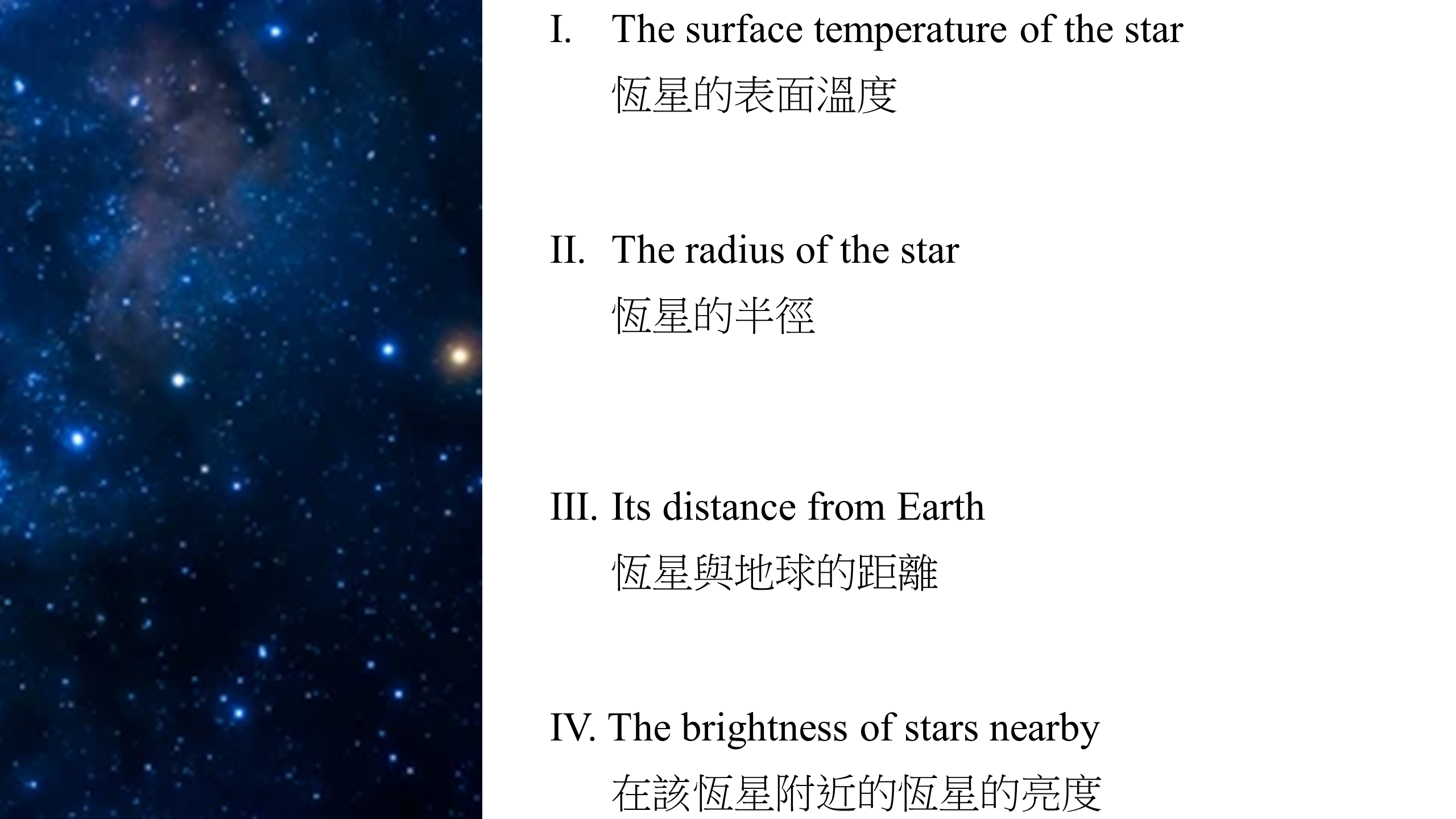Question 1
Which one of the followings is the largest in size?

(a) Mercury
(b) Pluto
(c) Earth
(d) Mars
Question 2
Apparent magnitude is a measure of the brightness of a star or other astronomical object observed from Earth, which factors determine the apparent magnitude of a star?

(a) I and III
(b) I, II and III
(c) I only
(d) II, III and IV
Question 3
Institut Pasteur, an international renowned centre for biomedical research, is credited for several ground-breaking scientific discoveries, including the discovery of the AIDS virus. Who, from the followings, was NOT the three scientists responsible for this discovery?

(a) Luc Montagnier
(b) Jean-Claude Chermann
(c) Françoise Barré-Sinoussi
(d) Harvey J Alter
Question 4
Which wave does a gravitational wave most closely resemble?

(a) A ripple in a pool of water
(b) A Slinky being stretched and released
(c) Sound wave
(d) None of the above
Question 5
What scientific instrument is currently used to detect gravitational waves?

(a) Particle collider
(b) Laser interferometer
(c) Radio telescope
(d) Microscope
Question 6
What is a light-year?

(a) Unit of time defined via the property of light
(b) Property of time under different gravitational forces
(c) Unit of distance defined via the property of light
(d) None of the above
Answer
Question 1: (c) Earth
The radius of Mercury is about 2,439.7 kilometers.
Pluto is a dwarf planet and it is smaller than a typical planet. Its radius is about 1,188.3 kilometers.
The radius of Earth is about 6,371 kilometers.
The radius of Mars is about 3,389.5 kilometers.
Question 2: (b) I, II and III
Higher surface temperature, larger radius and shorter distance from Earth can give rise to a brighter star. However, the brightness of stars nearby has no effect on the apparent magnitude.
Question 3: (d) Harvey J Alter
Discovery of the AIDS viruses, HIV1 then HIV2, was by Luc Montagnier, Jean-Claude Chermann and Françoise Barré-Sinoussi. The isolation was achieved in 1983. The Nobel Prize in Physiology or Medicine 2008 was subsequently awarded to Professors Françoise Barré-Sinoussi and Luc Montagnier for their discovery of the human immunodeficiency (AIDS) virus. Harvey J Alter is an American medical researcher who shared the Nobel Prize in Physiology or Medicine in 2020 with Michael Houghton and Charles M Rice for the discovery of Hepatitis C virus.
Question 4: (a) A ripple in a pool of water
Gravitational waves are transverse waves, meaning they stretch space in the directions they do not propagate in. This is like a water ripple, which extends water up and down as the wave moves along the surface of the water. Sound waves and the stretching/squeezing of a slinky are examples of longitudinal waves where the wave effects are in the same direction as the wave propagation.
Question 5: (b) Laser interferometer
A gravitational wave scratches and squeezes space perpendicular to its travelling direction. This effect can be measured by a Michelson interferometer, which measures the differences between two perpendicular paths. A Michelson interferometer consists of a laser source, a beam splitter, two mirrors, and a photodetector. The beam splitter splits the laser into two perpendicular paths. The two mirrors, at the end of the two paths, reflect the beams towards the beam splitter. The two beams recombined at the beam splitter. At last, the photodetector measures the light power of the recombined beam, which varies based on the length difference in the two paths. However, the effect of gravitational waves is extremely tiny. For example, the first-ever detected gravitational wave only caused a peak length difference of about 1 part in 1000000... (followed by a total of 21 zeros). So, the interferometer can detect gravitational waves only if it’s built large enough. Current gravitational wave detectors have kilometre-scale interferometer arms. For a more detailed explanation, visit Laser Interferometer Gravitational-Wave Observatory’s (LIGO) webpage https://www.ligo.caltech.edu/page/what-is-interferometer
Question 6: (c) Unit of distance defined via the property of light
The light-year is the distance that light travels in a vacuum in one year. This astronomical unit highlights the consistency of the speed of light in vacuum, which is an assumption of Einstein’s special theory of relativity.


